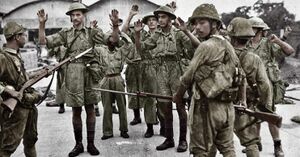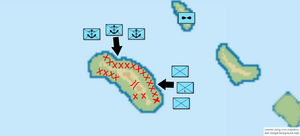Battle of Ayermer (1936)
| Battle of Ayermer | |||||||
|---|---|---|---|---|---|---|---|
| Part of Second Great War | |||||||
 Burgundie's soldiers surrendering | |||||||
| |||||||
| Belligerents | |||||||
|
|
| ||||||
| Commanders and leaders | |||||||
|
|
| ||||||
| Units involved | |||||||
| Daxian Armed Forces | Army of Burgundie | ||||||
| Strength | |||||||
| 70,000 | 40,000 | ||||||
| Casualties and losses | |||||||
|
3,543 killed 6,855 wounded |
2,654 killed 37,000+ captured | ||||||
The Battle of Ayermer, also known as the Siege of Ayermer took place in the Alshar theater of the Second Great War. Long a point of contention between the two empires and a dangerous impediment to Daxiaese naval forces in the area, the island was captured after four months of heavy fighting both in land and in the surrounding waters. The surprise assault on the island marked Daxian entry into the war, after a secret protocol was signed with Caphiria in which the Qian agreed to open another front to draw Burgundie's resources thin. The loss of Ayermer and its garrison was a heavy blow to Burgundie's armed forces and its capture allowed the Harmonious Flotilla Invincible to move into the western Taizi Sea and threaten Burgundie's colonies. The battle was preceded by an unsuccessful siege of the island in late 1934.
Background
This page is currently undergoing major reconstruction in accordance with broader lore changes. |
See Also: Rusana Levantine Exploration, Alshar Quasi-Wars
The island of Ayermer had long been administered as the Ayermer Colony by Burgundie since at least 1616 by the Ularien Trading Company, which was renamed the Marialanii Ularien Trading Company in 1705. The company maintained the island of Ayermer as a trading post and as a part of La Garrote to control trade and fight piracy in the Pukhtun Sea. This primarily impacted Daxiaese trading traversing westerly. Attempts were made by the Qian dynasty to take the island, most notably in the 1685 Siege of Ayermer which was ultimately repulsed. Daxian naval merchant fleet developed alternate routes to the east to avoid Ayermer and while relations remained sour, Audonia was a market it could not exploit. Burgundie's mercantile outpost in southern Rusana fell around 1802 but the island continued to be strongly held and supplied from Pukhgundi. The development of new naval technologies and sea based artillery and the introduction of these technologies into the Daxian arsenals in the late 1800's and early 1900's gave military planners new hopes for taking the island in a future war.
At the onset of the Second Great War a secret protocol was signed with the Imperium of Caphiria that stipulated that the Qian would initiate an attack on Burgundie's possessions in Alshar, and in exchange three fully equipped battleships (originally meant for Zaclaria) would be transferred to Daxia. These vessels would have to traverse a circuitous route and would not be able to participate in the battle. Daxian preparations for the attack took place over the first half of 1936, with great care being taken to maintain operational secrecy. New aircraft runways, supply depots and a radar station were constructed in Gochi island to support the invasion. Nonetheless the Ayermer garrison commander, (insert burg man here), was suspicious of Daxian fleet movements and requested that more reinforcements be sent to the island, which was granted? The start of the invasion was set for August 1936, while most of Burgundie's naval assets were focused on (insert random burg front).
Opposing forces
Daxian Qian forces
Harmonious Flotilla Invincible (Admiral Hong Ming)
Western Squadron composed of 40 vessels divided as follows:
- 9 battleships
- 7 cruisers
- 14 destroyers
- 10 minesweepers
Ayermer Expeditionary Force (General Qiu Heng)
Approximately 70,000 men
- 1st Imperial Marines Division
- 12th Imperial Marines Division
- 32nd Imperial Infantry Division
- 5th Imperial Infantry Division
- Zaclarian Volunteer Brigade
In addition 300 fighter planes and 70 tactical bombers were based at Gochi island
Burgundie's forces
Ayermer Garrison
- Army of Burgundie:
- Ville de Ayermer Capital Guard Regiment
- Company of Martillien Artillerists, Ancient and Honorable
- 43rd Coastal Defence Regiment
- 9th Regiment of Foot, Ayermer Volunteer Militia
- 10th Regiment of Foot, Ayermer Vounteer Militia
- 7th Troop, Ayermer Vounteer Calvary Guides
- Navy of Burgundie:
- Cathay Squadron (1x French seaplane carrier Commandant Teste (flag ship), 1x French cruiser Pluton, 2x Bourrasque-class destroyer, 3x Arabe-class destroyer, 2x Arabis-class sloop, 3x Aubrietia-class sloop, 5x Arras-class aviso
- Revenue Guard:
- 17th Cutter Pod
- 84th Cutter Pod
- 9th Life Saving Squadron
- National Gendarmerie of Burgundie:
- Ayermer Company of the Overseas Gendarmerie
September Reinforcements
Taskforce 153:
- 1x Vauquelin-class destroyer (flag ship)
- 1x French seaplane carrier Commandant Teste
- 2x Aigle-class destroyer
- 6x Bougainville-class aviso
3rd Ashari Division of the Burgoignesc Foreign Legion
October Reinforcements
Taskforce 262:
- 2x French cruiser Algérie (flag ship)
- 1x aircraft carrier
- 3x Le Fantasque-class destroyer
- a bunch of other ships, this one is going to be a big last ditch effort
2 divisions of Foreign Legionnaires
Campaign
Naval battle with Burg task force possibly
Daxian shore bombardment and landing

General Qiu Heng requested ten days of naval bombardment before the amphibious landing operations took place, a request which was turned down by the navy since it would deplete the task forces's available ammunition. A seven day bombardment was agreed as a compromise. Areas along the eastern shore were divided between the heavy warships to cover the maximum area of the island as possible. Bombardment of Ayermer began on 24th August 1936 by the nine battleships under Admiral Hong Ming. Approximately 3,000 410 mm shells were delivered over a distace of seven kilometers on the eastern defenses of the island. The warships fired for a period of six hours before stopping for a time. The second and third days of the bombardment were hampered by heavy rains and cloud coverage which impeded targeting.
Burgundie's relief attempts
Daxian breakthrough
Surrender
Aftermath
Analysis
Expulsion of Levantian population